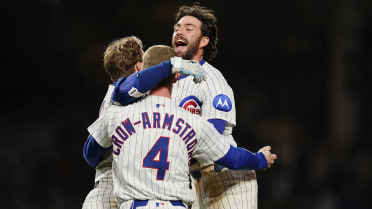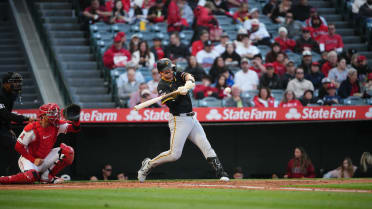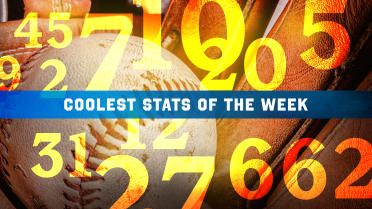The most dominant 2017 season you didn't notice came from a 27-year-old rookie pitcher with a modest professional track record. The year before, he was designated for assignment more times (three) than he pitched in a big league game (one).
Yet from that unlikely place, Indians left-hander Tyler Olson emerged in unprecedented fashion.
Called up from Triple-A Columbus in the second half, Olson helped Cleveland win an American League-record 22 consecutive games on its way to a 102-60 record and an AL Central championship. He did it by being something almost nobody ever is in the failure-filled game of baseball -- perfect.
In 20 innings over 30 regular-season relief appearances, Olson did not allow an earned or unearned run (he added three scoreless appearances and two innings in the AL Division Series). Since at least 1901, no other pitcher has produced a scoreless season of more than 14 games (the Mets' Eric Gunderson in 1994) or 18 innings (the Dodgers' Karl Spooner in '54).
By making the most of his limited opportunity, Olson generated 1.2 wins above replacement (WAR), according to Baseball-Reference.com, while facing 77 batters. No other pitcher or position player in 2017 managed at least 1 WAR with fewer than 98 batters faced or plate appearances. And no pitcher since Boston's Luis Aponte in 1981 had reached the 1-WAR plateau while facing fewer batters than Olson.
Here are five things to know about Olson's out-of-nowhere arrival:
1. A circuitous path to Cleveland
Drafted by the Mariners out of Gonzaga in the seventh round in 2013, Olson spent three seasons in the Seattle organization, debuting in the Majors for 11 games in '15. But between that December and the end of this past July, the southpaw went for a wild ride, as follows:
• Designated for assignment by the Mariners (December 2015)
• Traded to the Dodgers (December 2015)
• Traded to the Yankees (January 2016)
• Designated for assignment by the Yankees (June 2016)
• Claimed by the Royals (June 2016)
• Designated for assignment by the Royals (July 2016)
• Claimed by the Indians (July 2016)
• Designated for assignment by the Indians; sent outright to Triple-A (August 2016)
• Contract selected by the Indians (July 2017)
That's five organizations -- three of them 2017 postseason qualifiers -- in the span of less than two years. Through it all, Olson made one MLB appearance with the Yankees in April 2016, then didn't see a big league mound again until last July 21. He pitched twice for the Tribe, was briefly optioned back to Columbus, then came back up for good on July 31.
2. Pick your spots
The Indians and manager Terry Francona got to 102 wins in part by putting players in a position to succeed. Olson's usage is a perfect example.
In 18 of his 30 appearances, Olson went less than one inning. Ten times, he faced exactly one batter, and his average of 2.6 batters faced per game was the fourth lowest in MLB (minimum 10 appearances).
Although he stifled right-handed batters (.504 OPS) nearly as well as lefties (.460) for the Tribe in 2017, Olson had displayed a significant platoon split throughout his pro career. Therefore, it makes sense that 54.5 percent of the southpaw's matchups came against same-side hitters. Only four lefties who faced at least 75 batters had the platoon advantage more often, led by fellow Tribe reliever Boone Logan (61.5 percent).
3. Drop that hook
No team in 2017 threw curveballs more often than the Indians (17.6 percent), who were followed by fellow division winners the Red Sox, Dodgers, Astros and Cubs. Loading up on breaking balls is in style, and Olson fit right in with that trend.
With a four-seam fastball that averaged only 89 mph, Olson went to his curve more than 41 percent of the time. That ranked sixth highest among those who threw at least 200 total pitches, and opponents had no answer for the hook, going 5-for-30 (.167) against it with one double and nine strikeouts.
4. No barrel peril
Olson's 18 strikeouts in 20 innings didn't stand out for a reliever in 2017, but what the lefty did do exceptionally well in his limited body of work was induce favorable contact.
Among all pitchers who generated at least 50 batted balls, according to Statcast™, Olson ranked in the top 20 in average exit velocity allowed (83.1 mph), average exit velocity allowed on fly balls and line drives (87.4 mph) and opponent hard-hit rate (23.1 percent).
None of the 52 balls put in play against Olson were barrels -- the most dangerous type of batted ball, based on exit velocity and launch angle -- with only fellow Tribe lefty Ryan Merritt (78 balls in play) topping that feat.
5. Great expectations
Statcast™'s expected weighted on-base average (xwOBA) metric takes into account the quality of contact made, plus actual strikeouts and walks. Boosted by his opponents' weak contact, Olson allowed a .251 xwOBA that tied him for 30th in the Majors (minimum 50 batters faced), compared with the MLB average of .304 for relievers. That put Olson just behind teammate and AL Cy Young Award winner Corey Kluber (.248).
So while Olson clearly won't be counted on to replicate his 0.00 ERA in 2018, his spectacular '17 performance qualifies as more than just luck.
Andrew Simon is a research analyst for MLB.com. Follow him on Twitter @AndrewSimonMLB.



